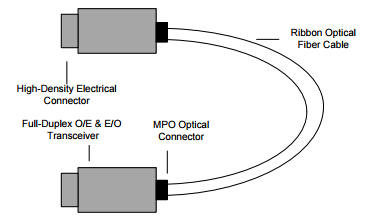As the demand for reliable, efficient and fast data transfer continues to heat up, the need for a more capable alternative to traditional copper cables also grows parallel with it. Achievements in network technologies have ushered in a new era with higher speed connectivity, thus migration from 10G to 40G nowadays is no longer a fresh topic but an irresistible trend. The active optical cable(AOC cable), since it was introduced in 2007, has been considered to be an optimum option for 40G support connectivity. This article will explain some vital elements in related to 40G QSFP+ AOC cable in detail.
40G QSFP+ AOC Cable Description
40G QSFP+ AOC cable, as the name indicates, is a type of active optical cable used for 40G networks and applications. It is terminated with 40G QSFP+ connector on one end, and on the other end, it can be terminated with QSFP+ connector, SFP+ connector or LC connector etc. The QSFP+ modules provide four parallel full-duplex transmit and receive channels, each capable of 10Gbps operation and in total 40Gbps aggregate bandwidth of at least 100 m over multimode fiber.
With a bit error rate (BER) exponentially better than that of copper cables, along with being lighter and with a tighter bend angle, AOC cables have since become mass-produced for data centers and server rooms all over the world.

How Does 40G QSFP+ AOC Cable Work?
The feature that distinguishes AOC cables from traditional types of connectors is the fact that data passes through optical fiber lanes as opposed to copper, while maintaining a traditional electrical connectivity interface. Besides, optical cable possess a greater capability to carry a high-speed signal over longer distances than any other types of cable, without compromising signal integrity. Not to mention that it ensures data security and non-conductivity.
All active optical cables are comprised of four main functional parts:
1. High-density connector: The form factor of the connector equipped to either side of the optical fiber cable can come in many variants to fulfill a variety of functions, whether in QSFP+ format for data centers and server rooms or HDMI format for consumer entertainment.
2. Ribbon optical fiber cable: A multi-channeled optical fiber cable (that could come in multi or single-mode) ranging from 1 to 100 meters in length.
3. Full-duplex AOC transceiver: An optical transceiver is embedded into either side of the optical cable, two optical-electrical and electrical-optical converters on either side of the cable.
4. MPO optical connector: A connector that is permanently fixed to the form factor shell and fiber, designed to shield the optical interface from external interference.

Comparison Between 40G QSFP+ AOC Cable and QSFP+ Optics
Currently, 40G QSFP+ AOC cable is becoming increasingly popular in data centers, especially those are supposed to accommodate massive and high density bandwidth. Then, how dose 40G QSFP+ AOC cable differ from standard QSFP+ optics? And what we can benefit from employing 40G QSFP+ AOC cable? Here, we simply make a comparison between them from the perspective of total cost, insertion loss and return loss.
Cost—by adopting 40G QSFP+ AOC cable to your existing infrastructure, there is no need to use extra fiber patch cables. So, it generally costs less when compared with QSFP+ optic modules. Let’s just take QSFP+ to QSFP+ AOC cables for example, it is usually employed to very short distance data transmission while offers a rather cost-effective way to establish 40G links between QSFP ports of switches within racks and across adjacent racks. Moreover, with 40G QSFP+ AOC cable, you will be free from cleaning the optical connectors as well as from termination plug and test when troubleshooting, which is time-saving and cost-efficient.
Insertion loss and return loss—when considering the repeatability and interchangeability performances within the same transmission distance, 40G QSFP+ AOC cable is superior to that of QSFP+ optics. Because when different fiber optic patch cables plug into the module, it will have the different insertion loss and return loss, which is the same even for the same module. However, an AOC cable is more stable and has better swing performance than other QSFP+ optics in this situation.
Conclusion
The 40G QSFP+ AOC cable is a high performance, low power consumption integrated cable for short-range multi-lane data transmission and interconnect applications. It has been widely used in high-density connectivity data centers to upgrade the current network equipment. 40G QSFP+ AOC cable also offers an optimum solution for high-performance computing and storage applications. So one can rely on 40G QSFP+ AOC cables when designing for higher speed and more reliable network connectivity. For more detailed products information and interconnect solutions, please visit www.fs.com.
Related Article: Active Optical Cable (AOC) – Rising Star of Telecommunications & Datacom Transceiver Markets
